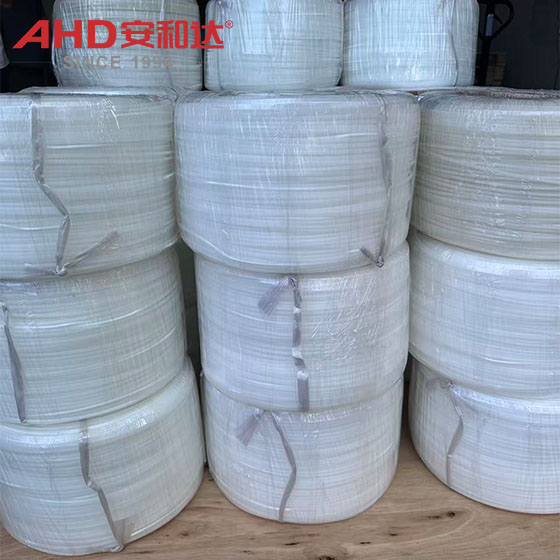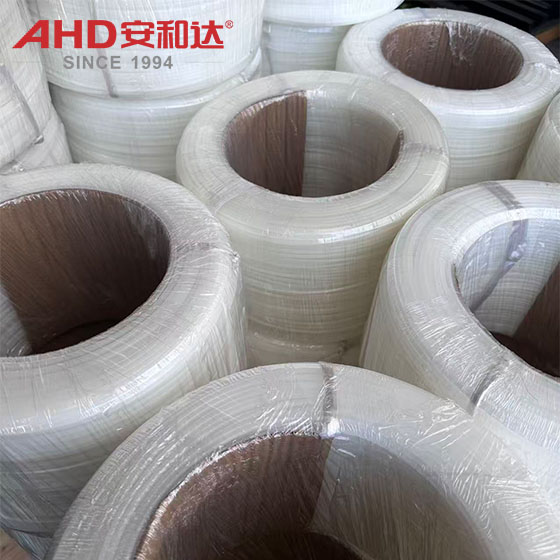Core Application Scenarios: The Practical Value of HDPE White Welding Rods
Installation and Repair of Plastic Piping Systems
Pipeline Joint Repair: Used for butt fusion welding or as an auxiliary for electric fusion welding of HDPE water supply pipes, sewage pipes, and irrigation pipes (if electric fusion is not possible on-site, hot air welding with welding rods can be used to fill gaps).
Leak Repair: For cracks, pinholes, or leaking joints in pipes, welding rods are heated with a hot air welding torch, melting and filling the defective area (creating a sealed weld).
Custom Reducers/Tees: When standard fittings are unavailable, HDPE sheets are cut and welded to the pipe, with welding rods filling the transition area (e.g., custom reducers).
Chemical and Environmental Protection Equipment
Storage Tanks and Reactors: Used for crack repair or weld reinforcement in HDPE acid and alkali storage tanks and sewage treatment tanks (resistant to corrosive media such as sulfuric acid and sodium hydroxide).
Diversion Channels and Pipelines: Used for on-site splicing of corrosion-resistant fluid transport pipes in chemical plants (replacing expensive custom fittings).
Agriculture and Water Conservancy Facilities
Irrigation Systems: Repair of damaged PE drip irrigation pipes and sprinkler mains (UV-resistant and suitable for outdoor environments).
Aquaculture Ponds/Cisterns: Rapid welding repair of leaking HDPE aquaculture ponds (resistant to organic pollutants such as feces and feed).
Custom Industrial and Civilian Parts
Plastic Boxes/Pallets: Welding of structural components of HDPE industrial turnover boxes and logistics pallets (such as reinforcement).
Laboratory Equipment: Joining corrosion-resistant laboratory benchtops and reagent tanks (non-toxic and GLP-compliant).
Welding Process and Key Operations (Critical to Ensuring Weld Quality)
Mainstream Welding Methods
- Hot Air Welding: Most commonly used (suitable for thin-walled pipes/sheets, diameter ≤160mm).
- Tools: Hot air welding gun (temperature 200-280°C) + welding rod (diameter matching the tip).
- Steps: Clean the base metal surface → Preheat the welding area → Simultaneously feed the welding rod and melt it → Pressurize and fuse → Cool to set.
- Extrusion Welding: Suitable for thick-walled pipes and large structures (such as tank repairs).
- Tools: Extrusion welding gun (with built-in welding rod melting and extrusion) + heated die.
- Steps: Heat the base metal → Molten welding rod is evenly extruded through the die → Fill the joint → Compact and cool.
Butt Fusion (for pipes): Usually no additional welding rod is required (directly fuses the pipe ends), but welding rods are required for complex structures or defect repairs.
Key Operational Considerations
- Base Material and Welding Rod Matching: Use welding rods of the same grade as the HDPE pipe/sheet (e.g., PE80/PE100) to avoid weld embrittlement due to material differences (for example, LDPE welding rods cannot be used to weld HDPE pipe).
- Surface Pretreatment: Before welding, wipe the base material and welding rod surfaces with acetone or a specialized cleaner to remove oil and dust (otherwise, pores or weak connections may occur).
- Temperature Control: The hot air welding gun temperature must be stable (excessively high temperatures can lead to carbonization of the welding rod, while excessively low temperatures can result in incomplete melting). Recommended range:
- Hot air temperature: 200-280°C (adjusted based on welding rod diameter; approximately 220°C for thin welding rods and 250-280°C for thick welding rods).
- Melted welding rod: The surface should be smooth and shiny, free of burnt or unmelted particles.
- Welding Speed and Pressure: Feed the wire at a constant speed (faster speeds result in incomplete fusion, slower speeds result in overheating), and apply appropriate pressure to ensure thorough fusion between the wire and the base metal.
- Cooling and Setting: After the weld is completed, allow it to cool naturally (do not touch or move it, as this may cause deformation and cracking). The cooling time is approximately 5-15 minutes (depending on thickness).



